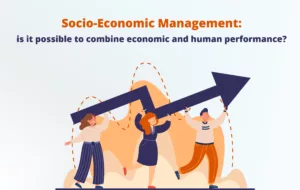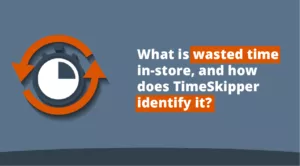30% turnover, disengagement, a shortage of vocations…
Store management is in crisis.
So in this context, why invest in training managers who might leave tomorrow?
According to Je Bosse en Grande Distribution, nearly one in three new hires are already considering quitting.
And yet, it’s precisely because turnover is a reality that training becomes a strategic lever. It enhances employee value, helps identify potential for growth, and preserves operational know-how. It strengthens the bond between motivation and the role itself.
So how and why should you keep investing in managerial training, when those you train today might be gone in five years?
Let us explain.
Training despite turnover: it’s more than worth it!
One question keeps coming up: is it really worth training managers… if they might leave soon after?
But what if the lack of training is actually one of the reasons they leave?
The numbers speak for themselves: according to LinkedIn, companies that invest in training have 94% of employees who say they want to stay longer. The link between continuous training, engagement, and retention is well-established: organizations that invest in skill development experience 12% less turnover than those that don’t (source: Conference Board).
So no, training your managers is far from a sunk cost. It’s a strategic lever to retain talent, boost engagement… and improve performance.
Because great managers don’t always come from outside. They’re often already there, on the floor, in the aisles, close to their teams and customers. What they lack are the tools to fully embrace their leadership role. Investing in training also means preparing the next generation, and ensuring everyone has the means to grow.
But for training to be truly effective, it must be built on the right foundations and the expectations and required skills for managers have changed dramatically in recent years.
What skills should today’s store managers develop?
Training a store manager doesn’t mean teaching them to do everything themselves. It means giving them the right reflexes to organize, lead, and develop their team while also driving the performance of their department or section.
Because yes, a good manager is both a team leader and a business owner. And to succeed in that role, certain qualities have become essential.
Supportive leadership with clear expectations
A good manager isn’t authoritarian a manager provides structure, guidance, and active listening. A manager knows when to make tough calls, speak up (even when it’s uncomfortable), and, most importantly, recognize success.
That’s what we call supportive leadership: both human and demanding.
Giving feedback — even when it’s negative — is a sign of respect. A manager doesn’t let someone continue making mistakes if the goal is to help them grow. On the other hand, highlighting what’s done well builds confidence and autonomy.
Because that’s the real goal: helping teams grow so they can take on more responsibility. By setting clear expectations, offering regular follow-up, and providing constructive oversight, a manager empowers the team to own both their role and their results.
Managing people while delivering performance
What we sometimes forget is that a manager is also accountable for sales, a P&L, and performance indicators. That means knowing how to allocate resources effectively: who is on the floor, when, doing what — and with what impact on the business.
This is where a manager’s ability to anticipate, steer, make trade-offs, and adjust in real time becomes critical: to ensure consistent service quality, avoid missed sales, and prevent team burnout. And yes — all of that at once!
So training a manager also means teaching them how to make smart decisions at the right time, and to be pragmatic, agile, and results-driven.
Curious, tech-Savvy, and refocused on his core role
Today, a manager shouldn’t have to carry everything alone. To better manage operations and focus on what really matters — the team and the customers — a manager needs to rely on the right tools.
That requires a certain level of tech curiosity — a willingness to explore, understand, and embrace solutions that make daily life easier without disconnecting from the shop floor.
Whether it’s tools to simplify inventory, apps to optimize fresh product ordering, or platforms like TimeSkipper to improve activity planning and performance management, the goal remains the same: making the most of time to stay focused on the core role — being a manager and a retailer.
The bridge between strategy and the shop floor
A good manager is, above all, a translator of strategy. A manager understands the objectives set by leadership, translates them into concrete actions for the team, and provides feedback from the shop floor. A manager is a sensor, a driver, and a relay — all at once.
Training a manager is therefore an investment in the fluidity of the organization, the engagement of the team, and the economic performance of the store.
So, how do you bring it all together — simply and effectively? Let us show you.
Using TimeSkipper: a training facilitator and accelerator
Training store managers has never been more essential. But that training still needs to fit their day-to-day reality. Between unexpected challenges, task allocation, and sales targets, it’s often hard to find the right moment and the right format to build new skills.
That’s where TimeSkipper introduces a new approach. The platform brings learning into action, turning everyday operations into real opportunities for growth. Each day becomes a chance to strengthen leadership posture, fine-tune practices, and look at situations differently.
In other words, a manager learns by doing — a bit like Monsieur Jourdain, who was writing prose without even realizing it…
Refocusing a manager on the role of a leader
TimeSkipper’s first strength lies in putting a manager back at the heart of the store and of the managerial mission. With a clear view of workloads, priorities, and available time, a manager regains control over both organization and leadership posture.
No more chasing emergencies: a manager anticipates.
No more improvising: a manager makes trade-offs.
No more reacting: a manager leads.
And by making decisions visible, the tool reinforces a manager’s legitimacy with the team. As one store partner put it: “TimeSkipper changed my grocery manager’s life. With the tool, he gained real credibility with his team.”
Fair management, objective feedback
Another key advantage of TimeSkipper is access to clear, objective data. No more instinct-driven management, decisions are now based on facts. Task distribution becomes fairer, and what is expected from teams is both realistic and achievable.
As a result, feedback becomes clearer. A manager no longer relies on gut feeling, but on tangible information. This makes conversations easier, highlights what’s working, and allows for improvement without ambiguity or tension.
As one manager put it: “TimeSkipper helped ease tensions within the team. Before, a lot of people thought they were doing more than the others.”
Establishing managerial rituals to strengthen team cohesion
By structuring the day around clear priorities, “TimeSkipper helps institutionalize managerial rhythms” — morning briefings, check-ins during the day, end-of-shift debriefs…
These moments of team coordination are essential for providing visibility, creating connection, and ensuring smooth information flow. But above all, they allow a manager to continuously observe the team. These regular touchpoints are key to spotting early warning signs: rising fatigue, disengagement, or growing tension within the team.
These rituals aren’t just one more task — they become powerful levers for cohesion, anticipation, and prevention. In short, they’re essential for managing a team sustainably.
Improving responsiveness without creating stress
Another key benefit: TimeSkipper brings calm to a manager’s daily routine by helping navigate the unexpected with greater ease.
A last-minute absence?
A task taking longer than planned?
An unexpected spike in foot traffic?
The tool allows a manager to adjust workload distribution in real time.
With a clear overview of the situation, a manager can react quickly and without stress — by reallocating resources or reprioritizing tasks. A manager stays in control… and that changes everything.
This sense of calm has a direct impact on the team: less tension, fewer sudden overloads, and a smoother workday for everyone.
As one store owner put it: “TimeSkipper allows managers to be more at ease. That naturally reflects on the teams, they feel calmer too, and as a result, more motivated.”
A launchpad for talent
TimeSkipper also acts as an accelerator for skill development. For high-potential employees, it provides a structured, progressive and accessible framework.
The tool is intuitive and visual: when it comes to managing daily operations, it doesn’t get any clearer. In just a few clicks, a manager (or future manager) can see where to focus efforts, how to distribute tasks, and where adjustments are needed.
There’s no need to be an expert. Anyone can quickly get the hang of it, build confidence, and take on responsibilities without pressure or guesswork.
As one store partner shared: “With TimeSkipper, we’ve improved the onboarding of new team members.”
Conclusion: train to last
To meet the challenges of modern retail, stores need strong managers, recognized, empowered, and aligned with their role. Training means anticipating needs, developing talent, and strengthening team cohesion.
From an HR perspective, TimeSkipper becomes a true partner in managerial development. It helps objectify progress, support internal career paths, and structure skill-building plans with concrete, field-based insights.
In short: TimeSkipper bridges the gap between theory and everyday application.






